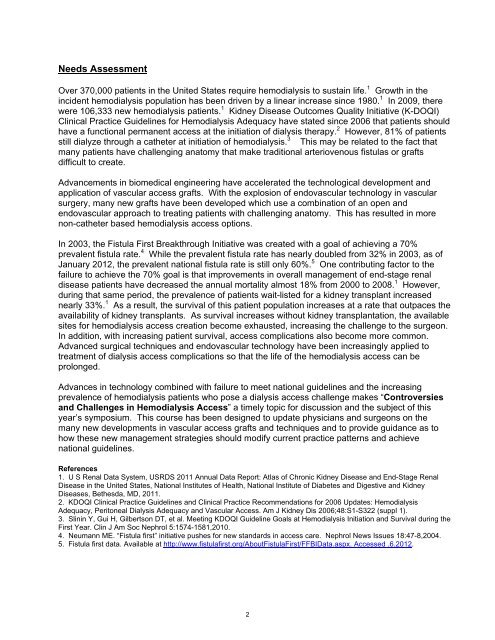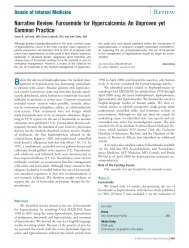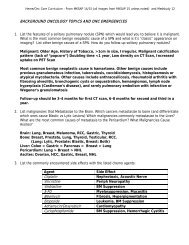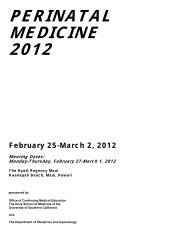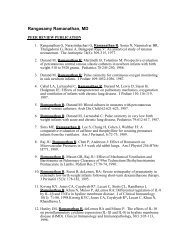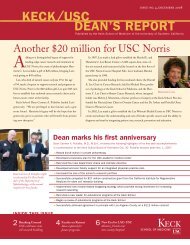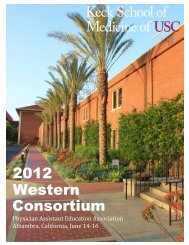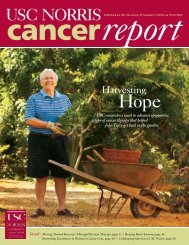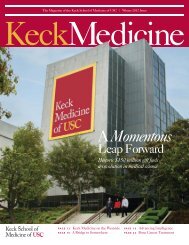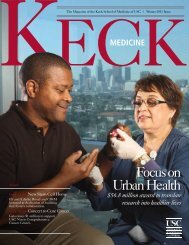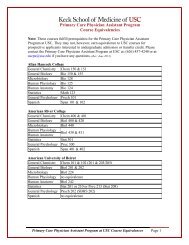Program Book - Keck School of Medicine of USC - University of ...
Program Book - Keck School of Medicine of USC - University of ...
Program Book - Keck School of Medicine of USC - University of ...
- No tags were found...
You also want an ePaper? Increase the reach of your titles
YUMPU automatically turns print PDFs into web optimized ePapers that Google loves.
Needs AssessmentOver 370,000 patients in the United States require hemodialysis to sustain life. 1 Growth in theincident hemodialysis population has been driven by a linear increase since 1980. 1 In 2009, therewere 106,333 new hemodialysis patients. 1 Kidney Disease Outcomes Quality Initiative (K-DOQI)Clinical Practice Guidelines for Hemodialysis Adequacy have stated since 2006 that patients shouldhave a functional permanent access at the initiation <strong>of</strong> dialysis therapy. 2 However, 81% <strong>of</strong> patientsstill dialyze through a catheter at initiation <strong>of</strong> hemodialysis. 3 This may be related to the fact thatmany patients have challenging anatomy that make traditional arteriovenous fistulas or graftsdifficult to create.Advancements in biomedical engineering have accelerated the technological development andapplication <strong>of</strong> vascular access grafts. With the explosion <strong>of</strong> endovascular technology in vascularsurgery, many new grafts have been developed which use a combination <strong>of</strong> an open andendovascular approach to treating patients with challenging anatomy. This has resulted in morenon-catheter based hemodialysis access options.In 2003, the Fistula First Breakthrough Initiative was created with a goal <strong>of</strong> achieving a 70%prevalent fistula rate. 4 While the prevalent fistula rate has nearly doubled from 32% in 2003, as <strong>of</strong>January 2012, the prevalent national fistula rate is still only 60%. 5 One contributing factor to thefailure to achieve the 70% goal is that improvements in overall management <strong>of</strong> end-stage renaldisease patients have decreased the annual mortality almost 18% from 2000 to 2008. 1 However,during that same period, the prevalence <strong>of</strong> patients wait-listed for a kidney transplant increasednearly 33%. 1 As a result, the survival <strong>of</strong> this patient population increases at a rate that outpaces theavailability <strong>of</strong> kidney transplants. As survival increases without kidney transplantation, the availablesites for hemodialysis access creation become exhausted, increasing the challenge to the surgeon.In addition, with increasing patient survival, access complications also become more common.Advanced surgical techniques and endovascular technology have been increasingly applied totreatment <strong>of</strong> dialysis access complications so that the life <strong>of</strong> the hemodialysis access can beprolonged.Advances in technology combined with failure to meet national guidelines and the increasingprevalence <strong>of</strong> hemodialysis patients who pose a dialysis access challenge makes “Controversiesand Challenges in Hemodialysis Access” a timely topic for discussion and the subject <strong>of</strong> thisyear’s symposium. This course has been designed to update physicians and surgeons on themany new developments in vascular access grafts and techniques and to provide guidance as tohow these new management strategies should modify current practice patterns and achievenational guidelines.References1. U S Renal Data System, USRDS 2011 Annual Data Report: Atlas <strong>of</strong> Chronic Kidney Disease and End-Stage RenalDisease in the United States, National Institutes <strong>of</strong> Health, National Institute <strong>of</strong> Diabetes and Digestive and KidneyDiseases, Bethesda, MD, 2011.2. KDOQI Clinical Practice Guidelines and Clinical Practice Recommendations for 2006 Updates: HemodialysisAdequacy, Peritoneal Dialysis Adequacy and Vascular Access. Am J Kidney Dis 2006;48:S1-S322 (suppl 1).3. Slinin Y, Gui H, Gilbertson DT, et al. Meeting KDOQI Guideline Goals at Hemodialysis Initiation and Survival during theFirst Year. Clin J Am Soc Nephrol 5:1574-1581,2010.4. Neumann ME. “Fistula first” initiative pushes for new standards in access care. Nephrol News Issues 18:47-8,2004.5. Fistula first data. Available at http://www.fistulafirst.org/AboutFistulaFirst/FFBIData.aspx. Accessed .6.2012.2


